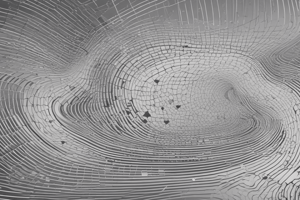Podcast
Questions and Answers
What does the magnitude of a vector represent?
What does the magnitude of a vector represent?
- The length between two points in space (correct)
- The total number of components in the vector
- The sum of the vector components
- The direction of the vector
What is the component form of a vector in three dimensions?
What is the component form of a vector in three dimensions?
- (a, b, c)
- (v, w, u)
- (i, j, k)
- (x, y, z) (correct)
How can a unit vector be obtained from a nonzero vector?
How can a unit vector be obtained from a nonzero vector?
- By adding zero to it
- By multiplying it by 1
- By subtracting its components
- By dividing it by its magnitude (correct)
How is vector subtraction performed?
How is vector subtraction performed?
When scalar multiplying a vector by a real number, what happens to the magnitude of the resulting vector?
When scalar multiplying a vector by a real number, what happens to the magnitude of the resulting vector?
What is the result of subtracting vector extbf{p} from vector extbf{q}?
What is the result of subtracting vector extbf{p} from vector extbf{q}?
In vector addition, how are two vectors combined to obtain the result?
In vector addition, how are two vectors combined to obtain the result?
What distinguishes vector quantities from scalar quantities?
What distinguishes vector quantities from scalar quantities?
What is the formula to calculate the magnitude of a vector with components v1, v2, and v3?
What is the formula to calculate the magnitude of a vector with components v1, v2, and v3?
How does scalar multiplication affect a vector's magnitude?
How does scalar multiplication affect a vector's magnitude?
Flashcards are hidden until you start studying
Study Notes
Vector Algebra: Understanding Components, Subtraction, Magnitude, Scalar Multiplication, and Addition
Vector algebra is a crucial concept in mathematics and physics, focusing on the manipulation of vector quantities. These quantities possess both magnitude and direction, differentiating them from scalar quantities which only have magnitude. In this article, we will delve into the subtopics of vector algebra, covering vector components, vector subtraction, vector magnitude, scalar multiplication, and vector addition.
Vector Components
Before performing algebraic operations on vectors, it's essential to understand their component form. A vector (\textbf{v}) in three dimensions can be written as a column vector, often denoted as ((v_{1}, v_{2}, v_{3})), where (v_{1}, v_{2},) and (v_{3}) represent the x-, y-, and z-components of the vector, respectively. This component representation allows us to apply standard vector algebra methods.
Vector Subtraction
Subtracting vectors involves reversing the direction of one vector and adding them together. Given two vectors (\textbf{p}) and (\textbf{q}), the result of their subtraction is found by adding (\textbf{p}) and (-\textbf{q}). This operation does not alter the original vectors and gives a new vector whose direction is opposite to the initial direction of (\textbf{q}).
Vector Magnitude
The magnitude ((|\textbf{v}|)) of a vector is a scalar quantity representing the length (or distance) between two points in space. For a vector (\textbf{v}), the magnitude can be calculated using the following formula:
[ |\textbf{v}| = \sqrt{v_{1}^{2} + v_{2}^{2} + v_{3}^{2}} ]
where (v_{1}, v_{2},) and (v_{3}) represent the components of the vector. A unit vector ((\hat{\textbf{u}})), which has a magnitude of 1, can be obtained from any nonzero vector (\textbf{v}) by dividing it by its magnitude:
[ \hat{\textbf{u}} = \frac{\textbf{v}}{|\textbf{v}|} ]
Scalar Multiplication
Scalar multiplication involves multiplying a vector by a scalar (a real number). The result of this operation is another vector whose magnitude is scaled down or up depending on the scalar value. For example, if we have a vector (\textbf{v}) and a scalar (k), the resulting vector from scalaring (\textbf{v}) by (k) is:
[ k\textbf{v} = (kv_{1}, kv_{2}, kv_{3}) ]
Vector Addition
Adding vectors follows similar rules to those in standard algebra. When adding two vectors (\textbf{p}) and (\textbf{q}), their components are added component-wise:
[ \textbf{p} + \textbf{q} = (p_{1} + q_{1}, p_{2} + q_{2}, p_{3} + q_{3}) ]
The result of this addition is also a vector with new x-, y-, and z-components.
These subtopics are fundamental building blocks for understanding more advanced concepts within vector algebra. By mastering them, one can confidently perform various algebraic operations on vectors and apply these principles to solve problems from diverse fields such as physics and engineering.
Studying That Suits You
Use AI to generate personalized quizzes and flashcards to suit your learning preferences.




